Chicago Youth Experience College,
Fun STEM Activities at Illinois
September 24, 2015
“We believe college graduation is not an option, but an expectation.” – Wanikka Vance, Head of School

Athrey Nadham (right) and a group of Foundations 4 Advancement students discuss which is the best type of material to use to make their stomp rocket.
When 30 or so Chicago youngsters visited campus for a tour and some hands-on STEM activities on September 17th, it shouldn’t have come as a surprise that the majority of the students were three, four, and five years old. According to Wanikka Vance, the founder and Head of Foundations 4 Advancement Christian College and Career Readiness Academy, it’s never too early to begin shaping youngsters into young entrepreneurs and inculcating into them this paradigm: they’re college-bound.
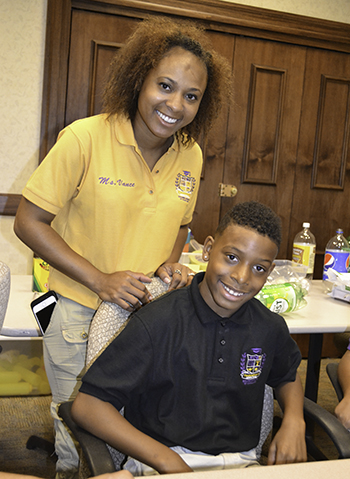
Head of School Wanikka Vance (left) and one of her students during their recent visit to Illinois.
“So we try to start that at the age of three," she admits, "instilling in them that they will go to college, and they will graduate from college, and then they will go on to create their own businesses and affect other people within their communities. So we’re trying to build legacies of excellence.”
In addition to exposing her charges to college early, Vance's philosophy also includes exposing them often. So she takes her students on trips to different colleges, both in and out of state, every month or so. Is it having the hoped-for impact? Vance says yes.
“Most of them know already what college they want to go to,” she indicates. “They know what they want to be when they grow up and then what businesses they also want to own. So we just make sure that we keep that at the forefront of their minds, as well as letting them know that academics is very important.”
In addition to expecting them to go to college, she also expects them to be entrepreneurs. Iin fact, some of them already are. They understand what business they want to go into and what it would take to actually have a successful business. Plus, each year, each student is expected to write his or her own business plan. Vance reports that last year, one of her four-year-olds wrote a two-page business plan, which she and her grandparents then followed to start an inflatable business...which is now up and running.

A Foundations 4 Advancement student designs and builds a marshmallow-toothpick structure..
“So she’s five, and she owns a full-fledged business,” boasts Vance.
At present, the school serves preschool thru fifth grade; however, their goal is to add a grade level a year until they reach 8th grade, and to add a child-care department as well.
“So we want to reach them from birth to 8th grade to give them a strong educational foundation."
Vance has an ambitious long-term goal, and a short-term goal in place in order to achieve it:
"We believe in changing the face of education, and so we’re going to change the face of education one child and one family at a time.”
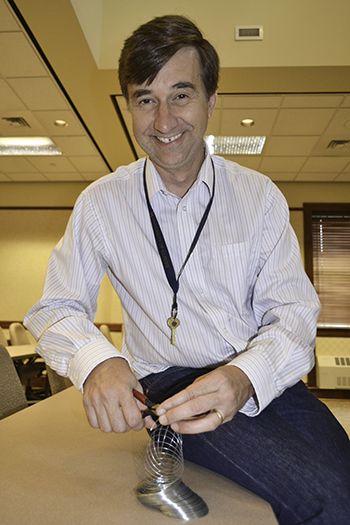
Joe Muskin cuts segments of wire for students to use in the "memory metal" activity.
A number of Illinois folks—excited about helping Vance make her college dream a reality—began some long-term recruiting of their own (for Illinois' Class of ’30) by showing the youngsters just how much fun STEM at Illinois can be.
Orchestrating the day's activities, performing demos, and supervising hands-on activities were Joe Muskin, the Mechanical Science and Engineering (MechSE) Education Coordinator; Muskin’s “right-hand man,” Athrey Nadhan, a MechSE senior who’s never met an outreach opportunity he didn’t like; Matt Goodman, a Materials Science and Engineering lecturer; and grad student Arif Nelson and several other students from Randy Ewoldt’s Rheology lab, who exposed the kids to the ever-popular Rheology Zoo, and its assortment of non-Newtonian funny fluids.
While Matt Goodman is used to teaching about materials to young students (MSE 280, an introduction to engineering for engineering students, plus MSE 101, teaching mostly non-engineers about engineering and materials), the group from Foundations 4 Advancement was quite a bit younger than the crowd he’s used to; but Goodman's an old hand at outreach, and simultaneously entertained and taught the kids about his favorite subject—materials.
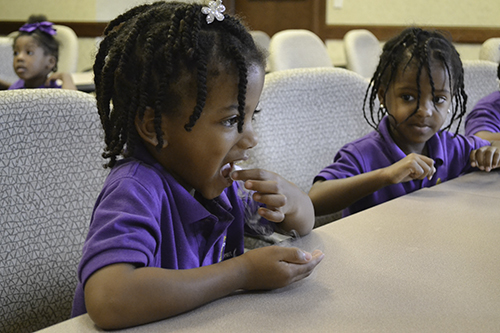
An intrepid young student prepares to taste a marshmallow which has been quick frozen in liquid nitrogen.
Armed with an arsenal of "mad-scientist-type" demos and hands-on opportunities, Goodman wowed the kids with his showmanship—and his science. He first demonstrated the effect liquid nitrogen has on various materials. To teach the students about the states of matter, he incorporated everyone's favorite pasttime: eating. Kids (and adults) sampled first a room-temperature miniature marshmallow, then one that had been a frozen in liquid nitrogen.
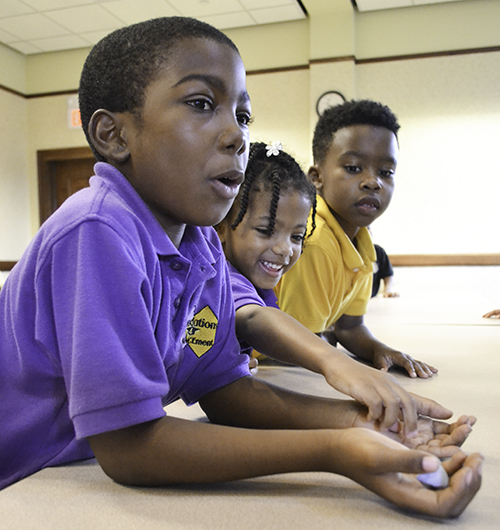
A student holds a piece of the ball, which no longer feels spongy but has turned into a cold, hard solid.
In another demo/hands-on activity, Goodman ecouraged the students to predict what would happen if he were to, say, throw a ball which had been immersed in liquid oxygen against a hard surface. They then watched (from a safe distance) to see if their theories were accurate as he did so. (The ball shattered, of course.) Students were then given a chance to hold one of the fractured pieces of ball to see that it was quite different from its original state.
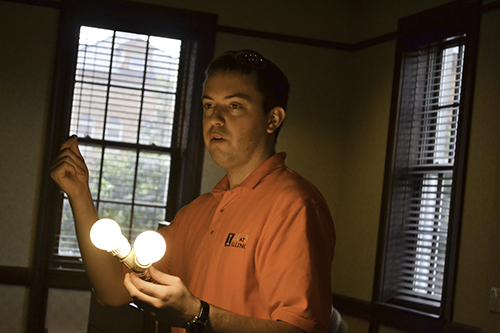
Matt Goodman shows the students the difference between an incandescent and an LED light bulb.
Exhibiting a number of light bulbs of various designs, Goodman did another activity in which he illustrated improvements scientists have made on the common light bulb by comparing the heat and light generated by various generations of light bulbs, ranging from an old-school incandescent to one of today's very efficient LEDs. Students were encouraged to judge for themselves which bulbs were the most energy efficient based on their light and heat output. (The LED won hands-down).
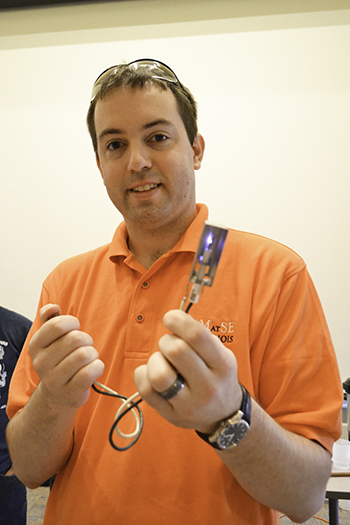
Matt Goodman ignites a spark by old-fashioned muscle energy.
Goodman also led the kids in a hands-on activity with memory metal; students were given a segment of wire, which they were encouraged to bend into a shape (see the photo at the bottom of the page); when the child immersed his/her wire in hot water, it "remembered" its previous shape (straight) and realigned itself accordingly.
Another of Goodman's activities involved materials that make good insulators because they are impervious to heat, such as the material used to construct the space shuttle. To demonstrate, he tested a styrofoam-like material with a blow torch, then let the kids feel the cool side.
Although the group, which had a lot of preschoolers, was younger than most groups who normally make field trips to Illinois, according to Goodman, the kids appeared to get a lot out of the activities.
“They did phenomenally," Goodman says. "They were engaged, excited. It was very surprising to see how much they were comprehending—and we're talking very high-level, technical, college-level items. Explaining it to them was a challenge, but they did grasp it very well.”
Goodman, no rookie to outreach, admits that he loves outreach because it's a great way to recruit new engineers into his field.
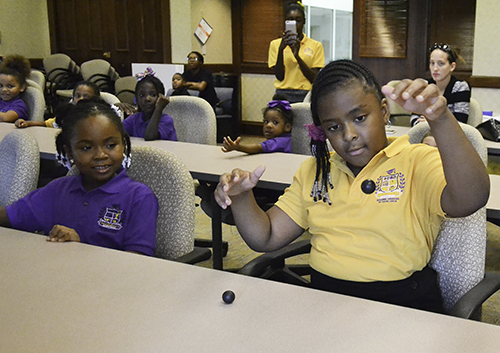
A student tests two balls of different density to see which of the two will bounce better.
“It’s just one of those things where I’ve always done them. When I was in high school, I had one of these outreaches done to me, and it really sparked my interest in materials engineering. So I think it’s just a way for me to give back and hopefully spark the interest of the next generation or future generations of engineers.”
Athrey Nadhan's portion of the day's activities gave the youngsters the opportunity to do a variety of hands-on activities: build marshmallow-toothpick structures; build Lego structures; and design, build, and launch stomp rockets.
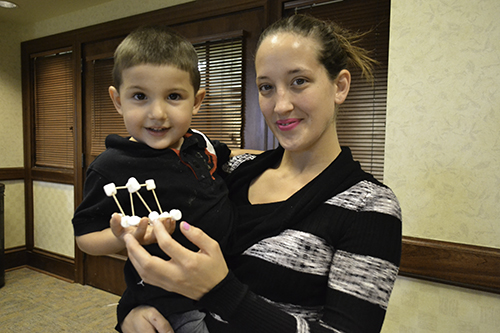
A young student and his mom (a teaching assistant at the school) shows off the marshmallow-toothpick structure he built.
Nadhan says he, too, participated in hopes of giving back and interesting some youngsters in STEM:
“The event really got the youngsters excited and pumped up about science,” he acknowledges. “I remember being in their shoes just a few years ago, watching mad scientist shows and participating in the science fair. It's a great feeling to give back to the community so that they can get the same thrill from science that I did as a kid.”
More: Chicago Public Schools, K-6 Outreach , Underserved Minorities, 2015
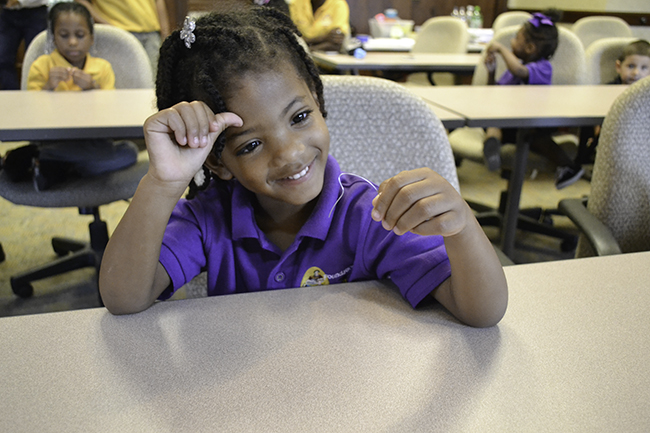
A young Foundations 4 Advancement student works with memory metal.
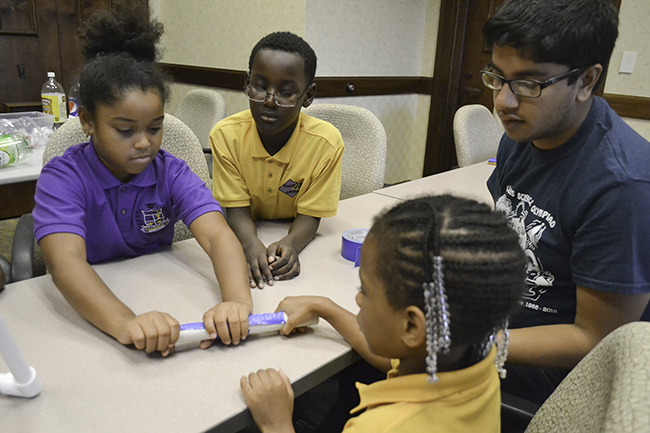
Athrey Nadhan (right) works with a team of students building their stomp rocket.













.jpg)
















